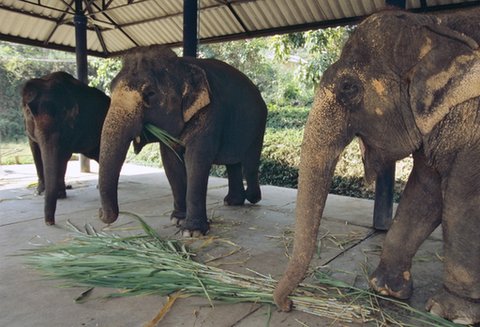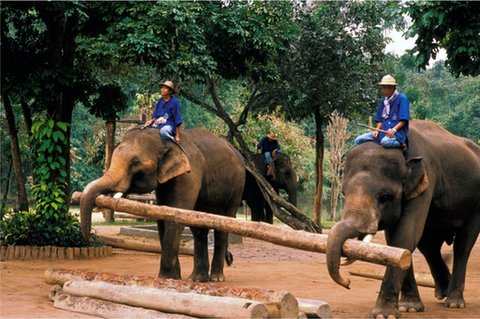




Atruckstopsinfrontofalarge,open-airstructure.Elephantsstandbeneaththeshadeoftrees.Severalmahouts,thecaretakersoftheelephants,helpunloadspikyvinesfromthetruck.WeareattheThaiElephantConservationCenter(TECC)innorthernThailand.Thesevineswillbeusedtomakeanherbalmedicineforthe elephants.
IfirstcametoTECCin2017,whileworkingasaguideforstudentgroups.Iquicklynoticedseveralinterestingthings.First,TECChadoneofthemostadvancedelephanthospitalsintheworld.Oneofthewaystheytreatedelephantswaswithherbalmedicine.Asanethnobotanist, Istudythewaysthatpeopleuse,rely on,andrelatetoplants.So,thiscaughtmy attention.

TheseelephantsliveattheThaiElephantConservation Center.


Elephantsusetheirtrunkstoliftgrassestotheir mouths.
Iknewthatplant-basedmedicineandbiomedicine(or“Western”medicine)aren’toftenfoundtogether.WhydidTECCusebothwhencaringfortheir elephants?
Next,Inoticedtheelephants’interestintheirherbalmedicine.Iknewthatelephantslovesweetfoods,justlikehumans.Theyeatgrass,butsugarcaneandcornarefavoritesnacks here.
Oneofthemahoutstoldmethatthespikyvinesareapowerfulmedicineforpeople.Itookatinynibble.ItwassobitterthatIneededadrinkof water.
Theelephants,however,happilyatethebitterplants.Why?Didtheyknowitwasmedicine?Ayearandahalflater,NationalGeographicSocietygavemeagrant.IwouldreturntoThailandtotrytofindthe answers.
Thesearepiecesofthespikyvineseatenby elephants.



IworkinthefieldwithaKareninterpreterandamaster healer.
WorkingWithElephants
ElephantshavecoexistedwithpeopleforthousandsofyearsinThailand.IdecidedtoworkwithagroupofhighlandpeoplecalledtheKaren.TheyliveinthemountainsofnorthernThailandandneighboring Myanmar.
TheKarenarefamousfortheirknowledgeofelephants.Howdidthisrelationshipbegin?Onestorytellsofhowtheelephantwasoriginallyhuman.Thenitlostitshumanityandbecameahelperof humankind.
Elephantsplayedaroleinnearlyeveryaspectoflifehere,similartohorsesinotherpartsoftheworld.Theirknowledgeoftheforestmeanttheywerethebestwaytotravellongdistancesover land.
Theirincrediblestrengthallowedthemtomoveheavyobjectslikestonesandsacksofrice.Manyelephantsworkedintheloggingindustry.Butascarsandtractorsreplacedolderwaysoflife,elephants’usefulness fell.

Twoelephantsworktogethertomove logs.




Loggingwithelephantsisconsideredmoreenvironmentallyfriendlythanusingmachines.But,centuriesofoverharvestingthreatenedremainingforests.In1989,loggingwas banned.
Elephantswerenolongerneededforthistypeofwork.Peopletriedtofindnewwaystokeeptheseincredibleanimals.Bynow,mostelephantshavebeenmovedtoelephantcampsfor tourists.




